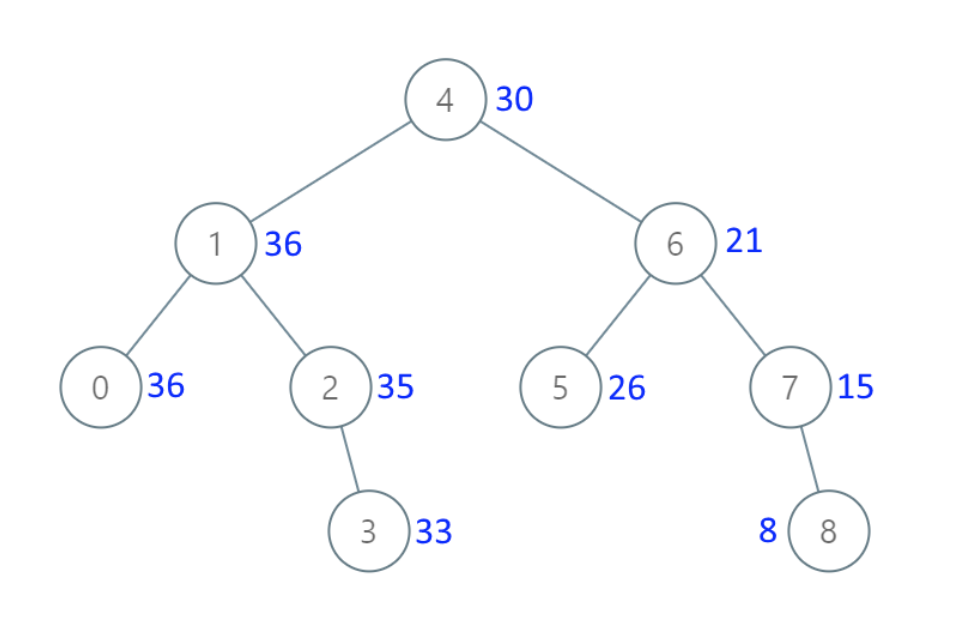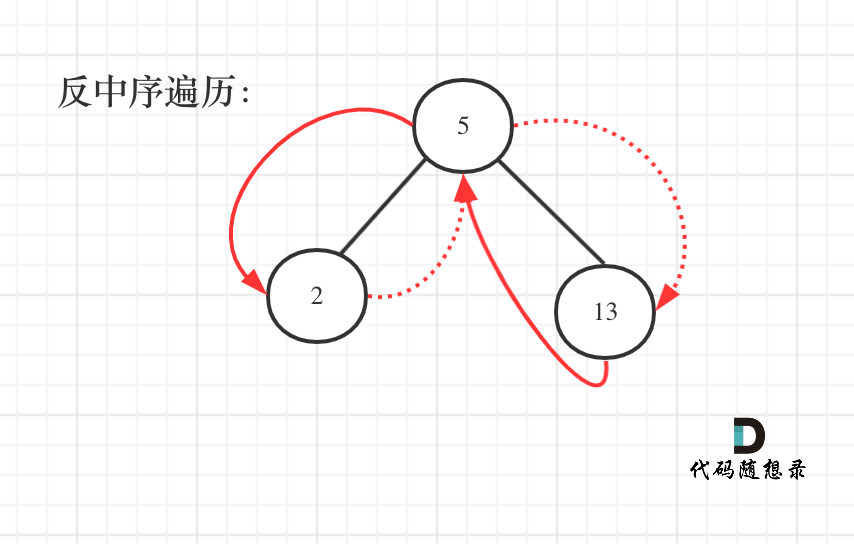参与本项目,贡献其他语言版本的代码,拥抱开源,让更多学习算法的小伙伴们收益!
给出二叉 搜索 树的根节点,该树的节点值各不相同,请你将其转换为累加树(Greater Sum Tree),使每个节点 node 的新值等于原树中大于或等于 node.val 的值之和。
提醒一下,二叉搜索树满足下列约束条件:
节点的左子树仅包含键 小于 节点键的节点。 节点的右子树仅包含键 大于 节点键的节点。 左右子树也必须是二叉搜索树。
示例 1:
- 输入:[4,1,6,0,2,5,7,null,null,null,3,null,null,null,8]
- 输出:[30,36,21,36,35,26,15,null,null,null,33,null,null,null,8]
示例 2:
- 输入:root = [0,null,1]
- 输出:[1,null,1]
示例 3:
- 输入:root = [1,0,2]
- 输出:[3,3,2]
示例 4:
- 输入:root = [3,2,4,1]
- 输出:[7,9,4,10]
提示:
- 树中的节点数介于 0 和 104 之间。
- 每个节点的值介于 -104 和 104 之间。
- 树中的所有值 互不相同 。
- 给定的树为二叉搜索树。
《代码随想录》算法视频公开课:普大喜奔!二叉树章节已全部更完啦!| LeetCode:538.把二叉搜索树转换为累加树,相信结合视频在看本篇题解,更有助于大家对本题的理解。
一看到累加树,相信很多小伙伴都会疑惑:如何累加?遇到一个节点,然后再遍历其他节点累加?怎么一想这么麻烦呢。
然后再发现这是一棵二叉搜索树,二叉搜索树啊,这是有序的啊。
那么有序的元素如何求累加呢?
其实这就是一棵树,大家可能看起来有点别扭,换一个角度来看,这就是一个有序数组[2, 5, 13],求从后到前的累加数组,也就是[20, 18, 13],是不是感觉这就简单了。
为什么变成数组就是感觉简单了呢?
因为数组大家都知道怎么遍历啊,从后向前,挨个累加就完事了,这换成了二叉搜索树,看起来就别扭了一些是不是。
那么知道如何遍历这个二叉树,也就迎刃而解了,从树中可以看出累加的顺序是右中左,所以我们需要反中序遍历这个二叉树,然后顺序累加就可以了。
遍历顺序如图所示:
本题依然需要一个pre指针记录当前遍历节点cur的前一个节点,这样才方便做累加。
pre指针的使用技巧,我们在二叉树:搜索树的最小绝对差和二叉树:我的众数是多少?都提到了,这是常用的操作手段。
- 递归函数参数以及返回值
这里很明确了,不需要递归函数的返回值做什么操作了,要遍历整棵树。
同时需要定义一个全局变量pre,用来保存cur节点的前一个节点的数值,定义为int型就可以了。
代码如下:
int pre = 0; // 记录前一个节点的数值
void traversal(TreeNode* cur)
- 确定终止条件
遇空就终止。
if (cur == NULL) return;
- 确定单层递归的逻辑
注意要右中左来遍历二叉树, 中节点的处理逻辑就是让cur的数值加上前一个节点的数值。
代码如下:
traversal(cur->right); // 右
cur->val += pre; // 中
pre = cur->val;
traversal(cur->left); // 左
递归法整体代码如下:
class Solution {
private:
int pre = 0; // 记录前一个节点的数值
void traversal(TreeNode* cur) { // 右中左遍历
if (cur == NULL) return;
traversal(cur->right);
cur->val += pre;
pre = cur->val;
traversal(cur->left);
}
public:
TreeNode* convertBST(TreeNode* root) {
pre = 0;
traversal(root);
return root;
}
};迭代法其实就是中序模板题了,在二叉树:前中后序迭代法和二叉树:前中后序统一方式迭代法可以选一种自己习惯的写法。
这里我给出其中的一种,代码如下:
class Solution {
private:
int pre; // 记录前一个节点的数值
void traversal(TreeNode* root) {
stack<TreeNode*> st;
TreeNode* cur = root;
while (cur != NULL || !st.empty()) {
if (cur != NULL) {
st.push(cur);
cur = cur->right; // 右
} else {
cur = st.top(); // 中
st.pop();
cur->val += pre;
pre = cur->val;
cur = cur->left; // 左
}
}
}
public:
TreeNode* convertBST(TreeNode* root) {
pre = 0;
traversal(root);
return root;
}
};经历了前面各种二叉树增删改查的洗礼之后,这道题目应该比较简单了。
好了,二叉树已经接近尾声了,接下来就是要对二叉树来一个大总结了。
递归
class Solution {
int sum;
public TreeNode convertBST(TreeNode root) {
sum = 0;
convertBST1(root);
return root;
}
// 按右中左顺序遍历,累加即可
public void convertBST1(TreeNode root) {
if (root == null) {
return;
}
convertBST1(root.right);
sum += root.val;
root.val = sum;
convertBST1(root.left);
}
}迭代
class Solution {
//DFS iteraion統一迭代法
public TreeNode convertBST(TreeNode root) {
int pre = 0;
Stack<TreeNode> stack = new Stack<>();
if(root == null) //edge case check
return null;
stack.add(root);
while(!stack.isEmpty()){
TreeNode curr = stack.peek();
//curr != null的狀況,只負責存node到stack中
if(curr != null){
stack.pop();
if(curr.left != null) //左
stack.add(curr.left);
stack.add(curr); //中
stack.add(null);
if(curr.right != null) //右
stack.add(curr.right);
}else{
//curr == null的狀況,只負責做單層邏輯
stack.pop();
TreeNode temp = stack.pop();
temp.val += pre;
pre = temp.val;
}
}
return root;
}
}递归法(版本一)
# Definition for a binary tree node.
# class TreeNode:
# def __init__(self, val=0, left=None, right=None):
# self.val = val
# self.left = left
# self.right = right
class Solution:
def convertBST(self, root: TreeNode) -> TreeNode:
self.pre = 0 # 记录前一个节点的数值
self.traversal(root)
return root
def traversal(self, cur):
if cur is None:
return
self.traversal(cur.right)
cur.val += self.pre
self.pre = cur.val
self.traversal(cur.left)
递归法(版本二)
# Definition for a binary tree node.
# class TreeNode:
# def __init__(self, val=0, left=None, right=None):
# self.val = val
# self.left = left
# self.right = right
class Solution:
def __init__(self):
self.count = 0
def convertBST(self, root: Optional[TreeNode]) -> Optional[TreeNode]:
if root == None:
return
'''
倒序累加替换:
'''
# 右
self.convertBST(root.right)
# 中
# 中节点:用当前root的值加上pre的值
self.count += root.val
root.val = self.count
# 左
self.convertBST(root.left)
return root
迭代法(版本一)
class Solution:
def __init__(self):
self.pre = 0 # 记录前一个节点的数值
def traversal(self, root):
stack = []
cur = root
while cur or stack:
if cur:
stack.append(cur)
cur = cur.right # 右
else:
cur = stack.pop() # 中
cur.val += self.pre
self.pre = cur.val
cur = cur.left # 左
def convertBST(self, root):
self.pre = 0
self.traversal(root)
return root迭代法(版本二)
class Solution:
def convertBST(self, root: Optional[TreeNode]) -> Optional[TreeNode]:
if not root: return root
stack = []
result = []
cur = root
pre = 0
while cur or stack:
if cur:
stack.append(cur)
cur = cur.right
else:
cur = stack.pop()
cur.val+= pre
pre = cur.val
cur =cur.left
return root弄一个sum暂存其和值
var pre int
func convertBST(root *TreeNode) *TreeNode {
pre = 0
traversal(root)
return root
}
func traversal(cur *TreeNode) {
if cur == nil {
return
}
traversal(cur.Right)
cur.Val += pre
pre = cur.Val
traversal(cur.Left)
}递归
var convertBST = function(root) {
let pre = 0;
const ReverseInOrder = (cur) => {
if(cur) {
ReverseInOrder(cur.right);
cur.val += pre;
pre = cur.val;
ReverseInOrder(cur.left);
}
}
ReverseInOrder(root);
return root;
};迭代
var convertBST = function (root) {
let pre = 0;
let cur = root;
let stack = [];
while (cur !== null || stack.length !== 0) {
while (cur !== null) {
stack.push(cur);
cur = cur.right;
}
cur = stack.pop();
cur.val += pre;
pre = cur.val;
cur = cur.left;
}
return root;
};递归
int pre;
void traversal(struct TreeNode* node) {
if(!node)
return ;
traversal(node->right);
node->val = node->val + pre;
pre = node->val;
traversal(node->left);
}
struct TreeNode* convertBST(struct TreeNode* root){
pre = 0;
traversal(root);
return root;
}递归法
function convertBST(root: TreeNode | null): TreeNode | null {
let pre: number = 0;
function recur(root: TreeNode | null): void {
if (root === null) return;
recur(root.right);
root.val += pre;
pre = root.val;
recur(root.left);
}
recur(root);
return root;
};迭代法
function convertBST(root: TreeNode | null): TreeNode | null {
const helperStack: TreeNode[] = [];
let curNode: TreeNode | null = root;
let pre: number = 0;
while (curNode !== null || helperStack.length > 0) {
while (curNode !== null) {
helperStack.push(curNode);
curNode = curNode.right;
}
curNode = helperStack.pop()!;
curNode.val += pre;
pre = curNode.val;
curNode = curNode.left;
}
return root;
};object Solution {
def convertBST(root: TreeNode): TreeNode = {
var sum = 0
def convert(node: TreeNode): Unit = {
if (node == null) return
convert(node.right)
sum += node.value
node.value = sum
convert(node.left)
}
convert(root)
root
}
}递归:
impl Solution {
pub fn convert_bst(root: Option<Rc<RefCell<TreeNode>>>) -> Option<Rc<RefCell<TreeNode>>> {
let mut pre = 0;
Self::traversal(&root, &mut pre);
root
}
pub fn traversal(cur: &Option<Rc<RefCell<TreeNode>>>, pre: &mut i32) {
if cur.is_none() {
return;
}
let mut node = cur.as_ref().unwrap().borrow_mut();
Self::traversal(&node.right, pre);
*pre += node.val;
node.val = *pre;
Self::traversal(&node.left, pre);
}
}迭代:
impl Solution {
pub fn convert_bst(root: Option<Rc<RefCell<TreeNode>>>) -> Option<Rc<RefCell<TreeNode>>> {
let mut cur = root.clone();
let mut stack = vec![];
let mut pre = 0;
while !stack.is_empty() || cur.is_some() {
while let Some(node) = cur {
cur = node.borrow().right.clone();
stack.push(node);
}
if let Some(node) = stack.pop() {
pre += node.borrow().val;
node.borrow_mut().val = pre;
cur = node.borrow().left.clone();
}
}
root
}
}// 递归
public class Solution
{
int pre = 0;
public TreeNode ConvertBST(TreeNode root)
{
if (root == null) return null;
ConvertBST(root.right);
root.val += pre;
pre = root.val;
ConvertBST(root.left);
return root;
}
}


